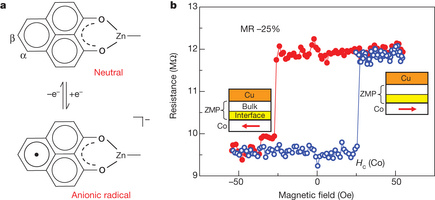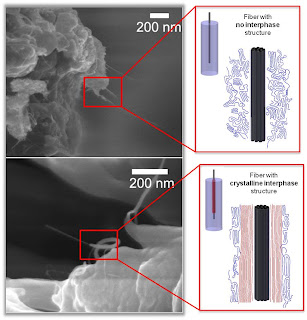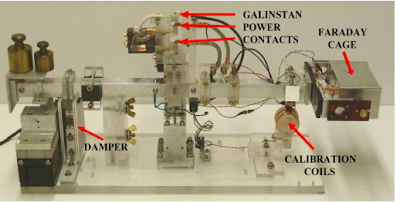Click here to read this mailing online.
Here are the latest updates for jorgeus.george@gmail.com
 "Next Big Future" - 5 new articles
"Next Big Future" - 5 new articles
- Aubrey de Grey (SENS Antiaging) interviewed on Gluck Radio
- A breakthrough in organic spin electronics to store one petabyte per square inch
- Mixing Polymer fiber and carbon nanotubes to make cheap material that is twice as strong as Kevlar
- PBS shows off 1.8 gigapixel video feed and analysis from a DARPA drone
- Impulse Drive - Mach Effect Thruster
- More Recent Articles
- Search Next Big Future
- Prior Mailing Archive
Aubrey de Grey (SENS Antiaging) interviewed on Gluck Radio46 minute podcast interview of Aubrey de Grey on Gluck radio. Aubrey is emphasizing that he wants to eliminate the diseases of aging and making people healthy. He is de-emphasizing the life extension.
Meet revolutionary scientist Aubrey de Grey. Aubrey started a foundation called SENS, which is looking to do what seems like the impossible: ending aging. Although Dr. de Grey sees aging as a disease and not a longevity issue, his research could mean that the middle aged person living today could live to 1000.

Read more » A breakthrough in organic spin electronics to store one petabyte per square inchAn international team of researchers affiliated with Göttingen University has found a way to store vast amounts of data - up to one petabyte - per square inch. One petabyte is equivalent to 1,000 terabytes or one million gigabytes. Using information stored in the spin of an electron, the scientists succeeded in storing the information in an organic molecule and reading it at a temperature close to room temperature.
Elementary particles, many atomic nuclei and atoms with certain electron configurations have what is called spin, defined as the rotation of a body around its own axis. This enables an alternative form of electronic data processing – called “spin electronics or spintronics.” The scientists developed a unique molecule that serves as the memory for their electronic device: They fused non-magnetic carbon atoms linked to one another in three benzene rings into one unit. Using spin injection, they chemically added an unpaired electron that carries a net spin. This can be exploited to store information as “0” and “1” by having the electron’s spin orientated up or down. Another accomplishment of the researchers was to use a magnetic reference electrode to read out the stored information at room temperature.
“Spin storage on an organic material and the successful reading at room temperature represent a breakthrough in organic spin electronics,” emphasised Prof. Markus Münzenberg, one of the physicists from Göttingen. “Spintronics integrated into flexible plastic components are already a familiar part of the organic LEDs employed in today's displays, TV screens and smartphones. Our recently developed molecular units have a similar potential.” Interface magnetoresistance effect. Molecular structure of zinc methyl phenalenyl (ZMP) in a neutral state with no net spin (top). Charge transfer processes through hybridization on the ferromagnet surface can change the chemical state. Nature - Interface-engineered templates for molecular spin memory devices Read more » Mixing Polymer fiber and carbon nanotubes to make cheap material that is twice as strong as KevlarTraditionally, carbon fibers are made by “carbonizing” a polymer called poly-acrylonitrile, or PAN. First, the polymer is spun into a fiber and then it is heated to very high temperatures. This causes the polymer molecules to to be converted into a homogenous carbon structure, causing the material to become a stiff solid.
Some research groups are designing new fibers that are made with 100 percent carbon nanotubes, which are among the strongest materials out there. But they’re extremely expensive. Marilyn Minus’ goal is to design a composite fiber that is twice as strong as current commercial materials, but cheaper.
To do so, she’s adding small amounts of nanotubes to the polymer fibers. The tubes, she says, act as needle-like skates allowing the long, flexible polymer chains to slide into a more ordered conformation. Now the spaghetti strands aren’t jumbled in a messy pile, but are neatly aligned, one strand evenly stacked atop the next. The alignment affords much stronger properties, says Minus. She’s playing around with several different types of polymers and nanomaterials and varying the concentrations of each. Ultimately she hopes to have a library of sorts, with a variety of materials designed for a variety of applications. Also, because she’s using textile grade polymers with only a small percentage of nanomaterials, the prices of her fibers may not be much higher than a silk shirt. And speaking of silk, Minus has already developed fibers that are stronger than spider silk — one of the strongest natural materials around. At the same time, her fibers are pushing the limits of Zylon, the strongest synthetic material currently available. Still at the beginning of her research, Minus believes there is still a lot room for improvement. Read more » PBS shows off 1.8 gigapixel video feed and analysis from a DARPA droneFrom an altitude of 17,500 feet a drone with a 1.8 gigapixel video camera can monitor half of Manhattan.
The interface shows the wide field of view all at once but 65 windows can be opened up showing zoom in views of different spots. They can see things as small as 6 inches like birds. They can make out people waving from the ground and what they are wearing. The software analyzes and tracks everything that is moving. All of the images is archived from every UAV. The persistent monitoring means that any past time can be selected for a monitored area and what happened at that time can be played as if you were watching it live. The sensor uses four lenses and 368 cell phone cameras, 5 megapixels each. 
Each chip is receiving the light from one tube. The video below does not reveal what the system looks like, but I am pretty sure it looks like the system shown in a patent from 2007. The ARGUS-IS, or the Autonomous Real-Time Ground Ubiquitous Surveillance Imaging System, is a Defense Advanced Research Projects Agency (DARPA) project contracted to BAE Systems. Nextbigfuture covered this system in 2009. Another DARPA project should have developed a 50 gigapixel camera out of off the shelf parts. Mass production could bring the cost of 50 gigapixel systems down to about $1000. 50 gigapixels would mean increasing resolution to make out 1 inch objects from 17500 feet or viewing a larger area at the 6 inch resolution. 
Read more » Impulse Drive - Mach Effect ThrusterThe Mach Effect Thruster (MET) is a device which utilizes fluctuations in the rest masses of accelerating objects (capacitor stacks, in which internal energy changes take place) to produce a steady linear thrust. The theory has been given in detail elsewhere and references therein, so here we discuss only an experiment. We show how to obtain thrust using a heavy reaction mass at one end of our capacitor stack and a lighter end cap on the other. Then we show how this thrust can be eliminated by having two heavy masses at either end of the stack with a central mounting bracket. We show the same capacitor stack being used as a thruster and then eliminate the thrust by arranging equal brass masses on either end, so that essentially the capacitor stack is trying to push in both directions at once. This arrangement in theory would only allow for a small oscillation but no net thrust. We find the thrust does indeed disappear in the experiment, as predicted. The device (in thruster mode) could in principle be used for propulsion. Experimental apparatus based on a very sensitive thrust balance is briefly described. The experimental protocol employed to search for expected Mach effects is laid out, and the results of this experimental investigation are described.
Suggestion from Advanced Space Propulsion Workshop in Huntsville Alabama for a null experiment. If we were to place identical brass masses on either side of our active PZT stack, then the mass fluctuations would result in pushes and pulls of equal magnitude and the device should just oscillate a little but show no average thrust. This appeared to be worth testing. It would show that we were able to eliminate any unwanted vibration, noise effects. Read more » More Recent Articles
|




